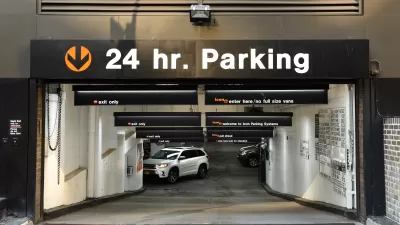Earth Island Journal takes an in-depth look at how and why congestion pricing got the kibosh in New York.
"On Earth Day 2007, Mayor Bloomberg put forth a 30-year redevelopment plan (PlaNYC) for the city that included congestion pricing as "part of an overall commitment to increase investment in mass transit." Although it was one of only 127 environmental initiatives, such as boosting street-side tree planting and protecting wetlands, congestion pricing received a disproportionate amount of attention, and led to a lively and often fractious debate among city and state lawmakers, local residents, and urban planners. A 17-member ad hoc committee was formed to hone the mayor's plan, and dozens of community meetings were held across the city to solicit residents' views. Bloomberg made the issue a top priority, and invested a large amount of his political capital in passing the measure. But the idea ran into stiff resistance. Opponents, particularly city council members and state assembly members who represent the outer boroughs, decried the legislation as a tax on the poor and middle class, one that would turn Manhattan into a golden ghetto. It was an effective populist appeal, an argument that everyone has the right to drive, and that right should not be infringed upon even if, in the case of NYC, the vast majority of commuters do not drive.
Ultimately, Bloomberg's plan, which narrowly made it through the city council, was scrapped by the state legislature in Albany. The NY state legislature often intervenes in city affairs, and reserves the right to oversee many local decisions – for example, the number and type of red light enforcement cameras, bus lane enforcement cameras, and speed limits for traffic calming designs. It is likely the city's authority to charge drivers would have been challenged in court, delaying the plan indefinitely. As it was, the assembly put the idea to rest."
FULL STORY: How NYC's Congestion Pricing Plan Crashed

Planetizen Federal Action Tracker
A weekly monitor of how Trump’s orders and actions are impacting planners and planning in America.

Restaurant Patios Were a Pandemic Win — Why Were They so Hard to Keep?
Social distancing requirements and changes in travel patterns prompted cities to pilot new uses for street and sidewalk space. Then it got complicated.

Map: Where Senate Republicans Want to Sell Your Public Lands
For public land advocates, the Senate Republicans’ proposal to sell millions of acres of public land in the West is “the biggest fight of their careers.”

Maui's Vacation Rental Debate Turns Ugly
Verbal attacks, misinformation campaigns and fistfights plague a high-stakes debate to convert thousands of vacation rentals into long-term housing.

San Francisco Suspends Traffic Calming Amidst Record Deaths
Citing “a challenging fiscal landscape,” the city will cease the program on the heels of 42 traffic deaths, including 24 pedestrians.

California Homeless Arrests, Citations Spike After Ruling
An investigation reveals that anti-homeless actions increased up to 500% after Grants Pass v. Johnson — even in cities claiming no policy change.
Urban Design for Planners 1: Software Tools
This six-course series explores essential urban design concepts using open source software and equips planners with the tools they need to participate fully in the urban design process.
Planning for Universal Design
Learn the tools for implementing Universal Design in planning regulations.
Heyer Gruel & Associates PA
JM Goldson LLC
Custer County Colorado
City of Camden Redevelopment Agency
City of Astoria
Transportation Research & Education Center (TREC) at Portland State University
Camden Redevelopment Agency
City of Claremont
Municipality of Princeton (NJ)





























